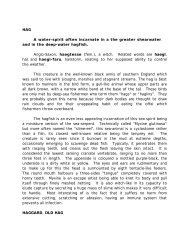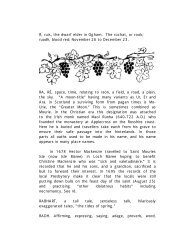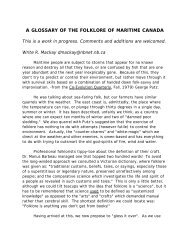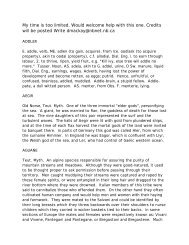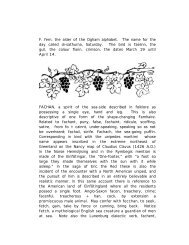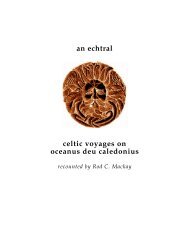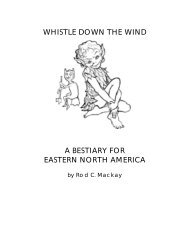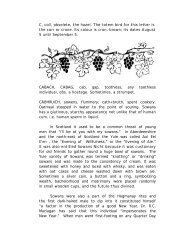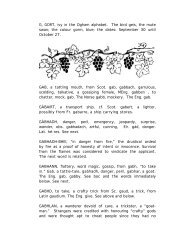L, luis, the mountain ash in the Ogham. Confers ... - Rodney Mackay
L, luis, the mountain ash in the Ogham. Confers ... - Rodney Mackay
L, luis, the mountain ash in the Ogham. Confers ... - Rodney Mackay
You also want an ePaper? Increase the reach of your titles
YUMPU automatically turns print PDFs into web optimized ePapers that Google loves.
Eric Maple says that <strong>the</strong> external power of <strong>the</strong><br />
universe is summed up <strong>in</strong> <strong>the</strong> word “luck.” “Luck is <strong>the</strong><br />
unknown goddess, perhaps <strong>the</strong> first deity ever to have been<br />
conceieved by primitive man, and possibly, when <strong>the</strong> last<br />
pan<strong>the</strong>on of <strong>the</strong> gods has crumbled to dust, she will rema<strong>in</strong><br />
<strong>the</strong> s<strong>in</strong>gle survivor of <strong>the</strong> ages of faith.” Possibly so, but<br />
“she” is noth<strong>in</strong>g more than <strong>the</strong> hermaphroditic aspect of<br />
Loki. Loki is recordered as a shape-changer who often<br />
appeared <strong>in</strong> female form, <strong>in</strong> fact, he/she was once<br />
impregnatedby Oid<strong>in</strong>’s stallion while <strong>in</strong> <strong>the</strong> body of a mare.<br />
LUACHAIR, rushes, EIr. luchair, “light-maker,” as <strong>the</strong>y were<br />
used as torches, from louk, light, <strong>the</strong> Lat. lux. Ultimately<br />
traceable to Lugh, <strong>the</strong> sun-god.<br />
LUACH-TUATHA, LUCHRAIGE, luch, a mouse. But see Lugh.<br />
These folk were called <strong>the</strong> Lugi by <strong>the</strong> Romans, and are<br />
believed to have occupied Su<strong>the</strong>rland proper or at least <strong>the</strong><br />
south-eastern part of that shire. Notice <strong>the</strong> G. luach, hav<strong>in</strong>g<br />
worth or value. Possibly related to <strong>the</strong> Gaull. Lougos, a<br />
raven, a black complexioned folk who were once <strong>the</strong>ir<br />
neighbours. Interest<strong>in</strong>gly, <strong>the</strong> people of Lochcarron <strong>in</strong> Rossshire<br />
were formerly called Fithich dubha Loch Carrann, <strong>the</strong><br />
“Black Ravens of Loch Carron,” a supposed reference to<br />
<strong>the</strong>ir swarthy complexions. See next.<br />
LUAIN, LUAN, DI-,(je loo<strong>in</strong>), Monday, moon-day. Lat. lux, luna.<br />
The Gaelic may be borrowed from Lat<strong>in</strong>. Note <strong>the</strong> Ir. phrase<br />
go la an Lua<strong>in</strong>, “until Doomsday” which suggests that <strong>the</strong><br />
word once personified <strong>the</strong> moon-goddess Samh. Obs.<br />
champion, hero, a lamb. Notice that <strong>the</strong> Samh was<br />
associated with death at <strong>the</strong> Samha<strong>in</strong>. Possibly derived<br />
from <strong>the</strong> Lat<strong>in</strong> luna. The day-name is similar to <strong>the</strong> Old<br />
Irish luan, <strong>the</strong> moon” and <strong>the</strong> French word lundi, or Monday.<br />
"Monday is a good day for chang<strong>in</strong>g one's residence, provided<br />
it be from north to south." (Celtic Monthly, p. 162). The<br />
moon goddess was sometimes personified as an lair bahn,<br />
<strong>the</strong> “white mare of <strong>the</strong> heavens”. In druidic tradition <strong>the</strong><br />
sun was often represented as a bull and moon as a cow.



